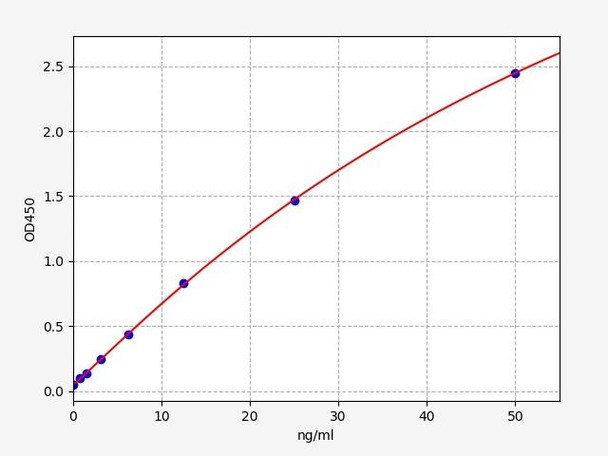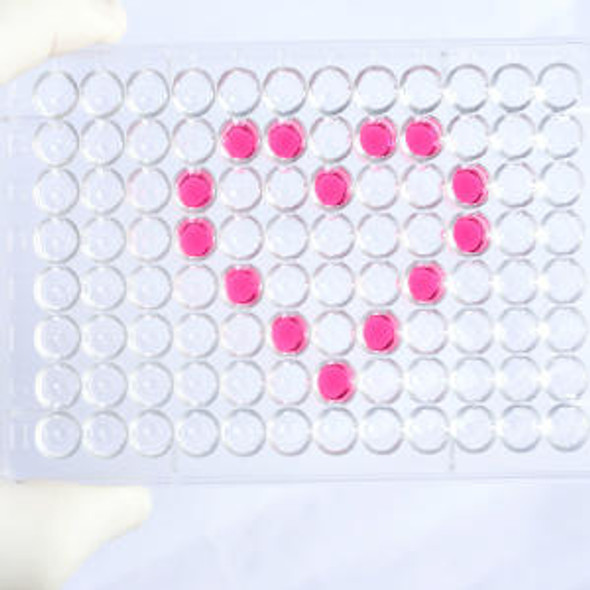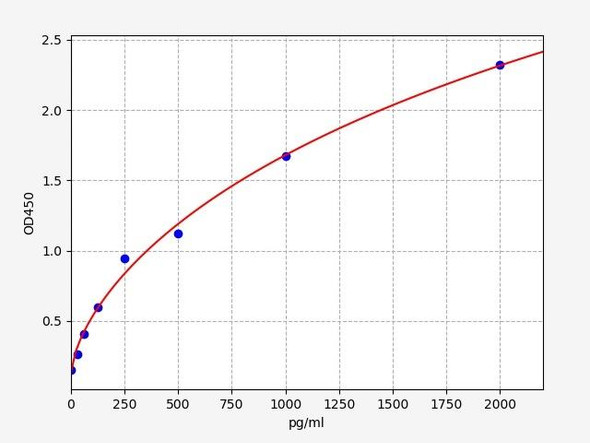Human beta1-ARA (beta 1 adrenergic receptor autoantibody) ELISA Kit (HUFI04725)
- SKU:
- HUFI04725
- Product Type:
- ELISA Kit
- Size:
- 96 Assays
- Uniprot:
- P08588
- Sensitivity:
- 0.469ng/ml
- Range:
- 0.781-50ng/ml
- ELISA Type:
- Indirect ELISA - Biotin
- Synonyms:
- beta 1-ARA
- Reactivity:
- Human
Description
| Product Name: | Human beta1-ARA (beta 1 adrenergic receptor autoantibody) ELISA Kit |
| Product Code: | HUFI04725 |
| Size: | 96 Assays |
| Alias: | beta 1-ARA ELISA Kit |
| Detection method: | Indirect ELISA - Biotin |
| Application: | This immunoassay kit allows for the in vitro quantitative determination of Human beta1-ARA (beta 1 adrenergic receptor autoantibody) concentrations in serum plasma and other biological fluids. |
| Sensitivity: | < 0.469ng/ml |
| Range: | 0.781-50ng/ml |
| Storage: | 4°C for 6 months |
| Note: | For Research Use Only |
| Recovery: | Matrices listed below were spiked with certain level of Human beta1-ARA (beta 1 adrenergic receptor autoantibody) and the recovery rates were calculated by comparing the measured value to the expected amount of Human beta1-ARA (beta 1 adrenergic receptor autoantibody) in samples. Enquire for more information. |
| Linearity: | The linearity of the kit was assayed by testing samples spiked with appropriate concentration of Human beta1-ARA (beta 1 adrenergic receptor autoantibody) and their serial dilutions. The results were demonstrated by the percentage of calculated concentration to the expected. Enquire for more information. |
| CV(%): | Intra-Assay: CV<8% Inter-Assay: CV<10% |
| Component | Quantity | Storage |
| ELISA Microplate(Dismountable) | 8×12 strips | 4°C for 6 months |
| Lyophilized Standard | 2 | 4°C/-20°C |
| Sample/Standard Dilution Buffer | 20ml | 4°C |
| Biotin-labeled Antibody (Concentrated) | 120ul | 4°C (Protect from light) |
| Antibody Dilution Buffer | 10ml | 4°C |
| HRP-Streptavidin Conjugate(SABC) | 120ul | 4°C (Protect from light) |
| SABC Dilution Buffer | 10ml | 4°C |
| TMB Substrate | 10ml | 4°C (Protect from light) |
| Stop Solution | 10ml | 4°C |
| Wash Buffer(25X) | 30ml | 4°C |
| Plate Sealer | 5 | - |
Other materials and equipment required:
- Microplate reader with 450 nm wavelength filter
- Multichannel Pipette, Pipette, microcentrifuge tubes and disposable pipette tips
- Incubator
- Deionized or distilled water
- Absorbent paper
- Buffer resevoir
| UniProt Protein Function: | ADRB1: a GPCR-coupled 7 transmembrane receptor that binds epinephrine and norepinephrine with approximately equal affinity. Mediates the catecholamine-induced activation of adenylate cyclase through the action of G proteins. Interacts with PIST and PSD-95. Localized at the plasma membrane and in the Golgi upon PIST overexpression. Homologous desensitization of the receptor is mediated by its phosphorylation by beta-adrenergic receptor kinase. |
| UniProt Protein Details: | Protein type:Membrane protein, multi-pass; Membrane protein, integral; Receptor, GPCR; GPCR, family 1 Chromosomal Location of Human Ortholog: 10q25.3 Cellular Component: early endosome; integral to plasma membrane; plasma membrane Molecular Function:alpha-2A adrenergic receptor binding; beta-adrenergic receptor activity; beta1-adrenergic receptor activity; epinephrine binding; norepinephrine binding; PDZ domain binding; protein binding; protein heterodimerization activity; Ras guanyl-nucleotide exchange factor activity; receptor signaling protein activity Biological Process: adenylate cyclase activation; brown fat cell differentiation; cell-cell signaling; diet induced thermogenesis; fear response; heat generation; negative regulation of multicellular organism growth; norepinephrine-epinephrine vasodilation involved in regulation of systemic arterial blood pressure; positive regulation of cAMP biosynthetic process; positive regulation of GTPase activity; positive regulation of heart rate by epinephrine-norepinephrine; positive regulation of the force of heart contraction by epinephrine-norepinephrine; response to cold; thermoregulation Disease: Resting Heart Rate, Variation In |
| NCBI Summary: | The adrenergic receptors (subtypes alpha 1, alpha 2, beta 1, and beta 2) are a prototypic family of guanine nucleotide binding regulatory protein-coupled receptors that mediate the physiological effects of the hormone epinephrine and the neurotransmitter norepinephrine. Specific polymorphisms in this gene have been shown to affect the resting heart rate and can be involved in heart failure. [provided by RefSeq, Jul 2008] |
| UniProt Code: | P08588 |
| NCBI GenInfo Identifier: | 48429211 |
| NCBI Gene ID: | 153 |
| NCBI Accession: | P08588.2 |
| UniProt Secondary Accession: | P08588,Q5T5Y4, Q9UKG7, Q9UKG8, B0LPE2, |
| UniProt Related Accession: | P08588 |
| Molecular Weight: | 51,323 Da |
| NCBI Full Name: | Beta-1 adrenergic receptor |
| NCBI Synonym Full Names: | adrenoceptor beta 1 |
| NCBI Official Symbol: | ADRB1 |
| NCBI Official Synonym Symbols: | RHR; B1AR; ADRB1R; BETA1AR |
| NCBI Protein Information: | beta-1 adrenergic receptor |
| UniProt Protein Name: | Beta-1 adrenergic receptor |
| UniProt Synonym Protein Names: | Beta-1 adrenoreceptor; Beta-1 adrenoceptor |
| Protein Family: | Beta-1 adrenergic receptor |
| UniProt Gene Name: | ADRB1 |
| UniProt Entry Name: | ADRB1_HUMAN |
*Note: Protocols are specific to each batch/lot. For the correct instructions please follow the protocol included in your kit.
Before adding to the wells, equilibrate the TMB substrate for at least 30 mins at 37 ? ?C. When diluting samples and reagents, ensure they are mixed completely and evenly. It is recommended to plot a standard curve for each test.
| Step | Protocol |
| 1. | Set standard, test sample (diluted at least « with Sample Dilution Buffer) and control (blank) wells on the pre-coated plate and record their positions. It is recommended to measure each standard and sample in duplicate. Wash plate 2 times before adding standard, sample and control (blank) wells! |
| 2. | Aliquot 100 µL of standard solutions into the standard wells. |
| 3. | Add 100 µL of properly diluted Sample into the sample wells. |
| 4. | Seal the plate with a cover and incubate at 37 °C for 90 mins. |
| 5. | Wash: Repeat the aspiration/wash process for 2 times. |
| 6. | Add 100 µL of Biotin-labelled antibody working solution into the bottom of each well (standard, test sample & zero wells) without touching the side walls. |
| 7. | Seal the plate with a cover and incubate at 37 °C for 60 mins. |
| 8. | Wash: Remove the cover, and wash plate 3 times with Wash buffer. |
| 9. | HRP-Streptavidin Conjugate (SABC): Add 100?l of SABC Working Solution into each well, cover the plate and incubate at 37 °C for 30 minutes. |
| 10. | Wash: Remove the cover and wash plate 5 times with Wash Buffer. |
| 11. | TMB Substrate: Add 90 µL of TMB substrate into each well, cover the plate and incubate at 37 °C in dark for 10-20 mins. (Note: This incubation time is for reference only, the optimal time should be determined by the end-user.) As soon as a blue colour develops in the first 3-4 wells (with most concentrated standards) and the other wells show no obvious colour, terminate the reaction. |
| 12. | Add 50 µL of Stop solution into each well and mix thoroughly. The colour changes into yellow immediately. |
| 13. | Read the O.D. absorbance at 450 nm in a microplate reader immediately after adding the stop solution. |
When carrying out an ELISA assay it is important to prepare your samples in order to achieve the best possible results. Below we have a list of procedures for the preparation of samples for different sample types.
| Sample Type | Protocol |
| Serum | If using serum separator tubes, allow samples to clot for 30 minutes at room temperature. Centrifuge for 10 minutes at 1,000x g. Collect the serum fraction and assay promptly or aliquot and store the samples at -80°C. Avoid multiple freeze-thaw cycles. If serum separator tubes are not being used, allow samples to clot overnight at 2-8°C. Centrifuge for 10 minutes at 1,000x g. Remove serum and assay promptly or aliquot and store the samples at -80°C. Avoid multiple freeze-thaw cycles. |
| Plasma | Collect plasma using EDTA or heparin as an anticoagulant. Centrifuge samples at 4°C for 15 mins at 1000 × g within 30 mins of collection. Collect the plasma fraction and assay promptly or aliquot and store the samples at -80°C. Avoid multiple freeze-thaw cycles. Note: Over haemolysed samples are not suitable for use with this kit. |
| Urine & Cerebrospinal Fluid | Collect the urine (mid-stream) in a sterile container, centrifuge for 20 mins at 2000-3000 rpm. Remove supernatant and assay immediately. If any precipitation is detected, repeat the centrifugation step. A similar protocol can be used for cerebrospinal fluid. |
| Cell culture supernatant | Collect the cell culture media by pipette, followed by centrifugation at 4°C for 20 mins at 1500 rpm. Collect the clear supernatant and assay immediately. |
| Cell lysates | Solubilize cells in lysis buffer and allow to sit on ice for 30 minutes. Centrifuge tubes at 14,000 x g for 5 minutes to remove insoluble material. Aliquot the supernatant into a new tube and discard the remaining whole cell extract. Quantify total protein concentration using a total protein assay. Assay immediately or aliquot and store at ≤ -20 °C. |
| Tissue homogenates | The preparation of tissue homogenates will vary depending upon tissue type. Rinse tissue with 1X PBS to remove excess blood & homogenize in 20ml of 1X PBS (including protease inhibitors) and store overnight at ≤ -20°C. Two freeze-thaw cycles are required to break the cell membranes. To further disrupt the cell membranes you can sonicate the samples. Centrifuge homogenates for 5 mins at 5000xg. Remove the supernatant and assay immediately or aliquot and store at -20°C or -80°C. |
| Tissue lysates | Rinse tissue with PBS, cut into 1-2 mm pieces, and homogenize with a tissue homogenizer in PBS. Add an equal volume of RIPA buffer containing protease inhibitors and lyse tissues at room temperature for 30 minutes with gentle agitation. Centrifuge to remove debris. Quantify total protein concentration using a total protein assay. Assay immediately or aliquot and store at ≤ -20 °C. |
| Breast Milk | Collect milk samples and centrifuge at 10,000 x g for 60 min at 4°C. Aliquot the supernatant and assay. For long term use, store samples at -80°C. Minimize freeze/thaw cycles. |










